Longford, Co. Longford
Longford Poor Law Union was formed 25th November 1839 and covered an area of 326 square miles. Its operation was overseen by an elected Board of Guardians, 30 in number, representing its 19 electoral divisions as listed below (figures in brackets indicate numbers of Guardians if more than one):
Co. Longford:
Agharra, Ardagh, Ballymahon (2), Ballynamuck (2), Cashel (2), Drumlish (3), Edgeworthstown (2), Forgney, Kilcommock, Kilglass, Killashee, Longford (4), Mohill, Moydow, Newtown Forbes (2), Rathline, Taghshenood, Taghshinny.
Co. Roscommon:
Tarmonbarry (2).
The Board also included 10 ex-officio Guardians, making a total of 40. The Guardians met each week on Saturday at noon.
The population falling within the Union at the 1831 census had been 85,152 with divisions ranging in size from Taghshinny (population 2,447) to Longford itself (10,344).
The new workhouse, built in 1840-42, was designed by George Wilkinson. It occupied a 7-acre site on Dublin Road, Longford, and was intended to accommodate up to 1,000 inmates. Its construction cost £7,000 plus £1,580 for fixtures and fittings etc. It was declared fit for the admission of paupers on 24th March 1842 and admitted its first inmates the same day. The workhouse location and layout are shown on the 1914 map below. The position of the main building, destroyed by a fire in 1909 (see below), is shown in yellow.
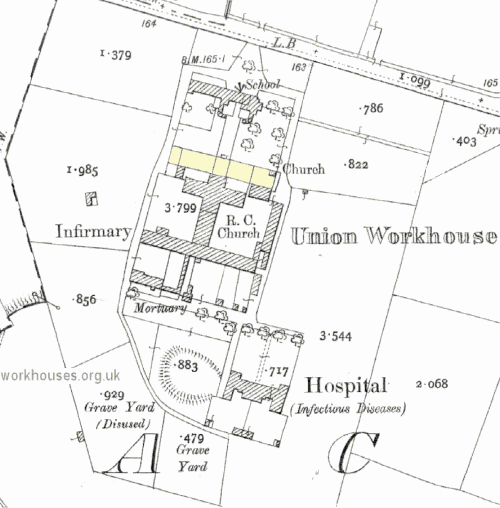
Longford workhouse site, 1914
The buildings appear to have broadly followed Wilkinson's typical layout. An entrance and administrative block at the north contained a porter's room and waiting room at the centre with the Guardians' board room on the first floor above. The block was later extended at its west side and on the 1914 map is indicated as being a school building.
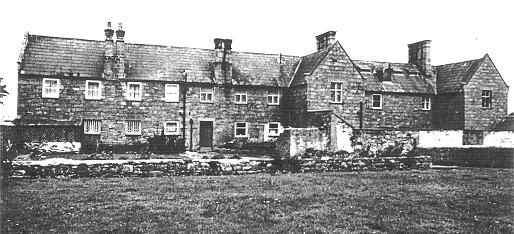
Longford rear of entrance block from the south.
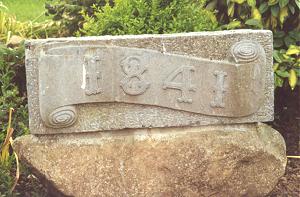
Longford entrance block date stone, 2000.
© Peter Higginbotham.
The main accommodation block had the Master's quarters at the centre, and male and female wings to each side. At the rear, a range of single-storey utility rooms such as bakehouse and washhouse connected through to the infirmary and idiots' wards via a central spine containing the chapel and dining-hall.
In common with other unions in Ireland, Longford suffered greatly during the famine years 1845-50. The workhouse was greatly overcrowded with over 2,300 inmates at the end of 1848. Disease, particularly typhus fever, was rife and a 64-bed fever hospital was erected at the south of the workhouse. Because of the spread of fever, the Board of Guardians moved their meetings away from the Board Room in the front block of workhouse and met in other places such as the town Courthouse.
As in other places, the number of deaths (over 16,000 in the first ten years of the workhouse's operation) necessitated the creation of mass graves in a famine graveyard on land adjoining the workhouse at the south. The graveyard which became known as "bully's acre" was also, in later years, used for the burial of still-born infants.
From 1877, the Sisters of Mercy provided the nursing staff in the workhouse infirmary.
The Irish poet Padraic Colum was born in 1881 at Longford workhouse, where his father was workhouse Master. Some of his poetry vividly evokes the famine times:
They carved the name above the gate, 1839,
When they built the workhouse on the hill
Of limestone tall and fine.
A plague wind blew across the land,
Fever was in the air.
Fields were black that once were green
And death was everywhere.
People came to drink the soup
Ladled from greasy bowls;
They died in whitewashed wards that
Held a thousand Irish souls.
(The Longford workhouse date-stone actually reads 1841 rather than 1839 and none of the new Irish workhouses came into use before 1841.) The Colum family were forced to leave their home at the workhouse in 1888 because of the Master's debts and lack of application to his duties.
On 29 March 1909, fire broke out in the main block of the workhouse, leaving it totally burned out. The evnt was described in a newspaper report of the time:
On Monday at 2 a.m. the alarm bell ringing at Longford Workhouse called out the town and military fire brigades to the scene of a fire in the main building, from the central windows of which flames wore issuing. On the arrival of the brigades there was no water available and they were helpleas. The building was completely gutted at nine o'clock. It appears that Mrs Devlin, the matron, was awakened, half-suffocated, by fumes from the kitchen below her bedroom. She called Mr Farrell, the master, who immediately sounded the fire alarm, and all the inmates were safely removed. There was no fire apparatus in the house and no water supply as the guardians had refused the necessary payment to the Town Council. An attempt was made stretch a hose from the town, a mile distant, but the hose was insufficient. The brigades then decided cut off the infirm women's quarters, letting the fire burn itself out. The insurance is with the Hibernian Aesurenoe Company for £4.000. Nothing but the bare walls are left standing.
At the 1901 census, the population of the Union was 22,312 with 17 officials and 208 inmates in the workhouse.
Following the creation of the Irish Free State in 1921, the Board of Guardians was abolished and the workhouse was redesignated Longford County Home. In 1952, it became St Joseph's Hospital, now known as St Joseph's Care Centre. Only the old fever hospital building now survives as Mount Carmel Hospital.
In the mid-1990s, to mark the 150th anniversary of the Great Famine, work was undertaken to renovate the graveyard which, by then, was totally neglected and overgrown. It has now been transformed into a landscaped area with commemorative cross and plaque.
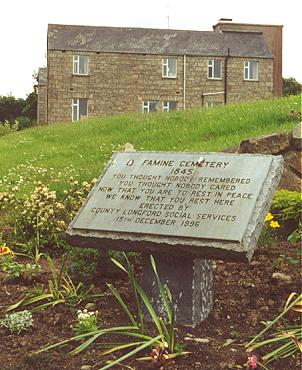
Longford workhouse memorial plaque, 2000.
© Peter Higginbotham.
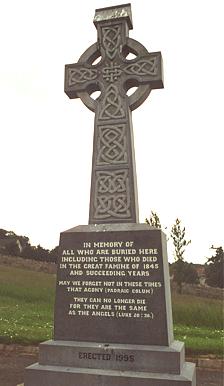
Longford workhouse memorial cross, 2000.
© Peter Higginbotham.
Staff
In 1905, workhouse staff were as follows:
- Master - James Farrell
- Matron - Eliza M'Nerney
- Chaplains - Very Rev. Dean Frederic Potterton (COI), Rev. B Geraghty (RC)
- Medical Officer - FJ McGuire
- Schoolmistress - Agnes Cogan
Records
Note: many repositories impose a closure period of up to 100 years for records identifying individuals. Before travelling a long distance, always check that the records you want to consult will be available.
- Longford County Library, Town Centre, Longford, Co.Longford. Holdings include Longford Union minute books (1839-1922).
Bibliography
- Higginbotham, Peter The Workhouse Encyclopedia (2014, The History Press)
Links
Unless otherwise indicated, this page () is copyright Peter Higginbotham. Contents may not be reproduced without permission.


